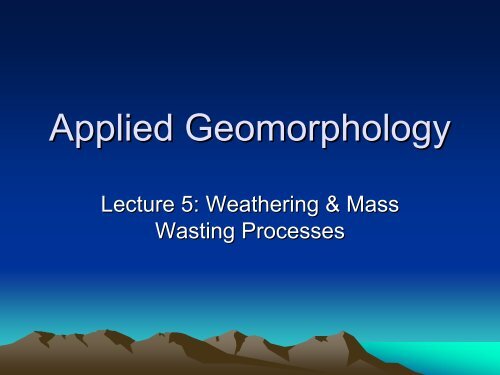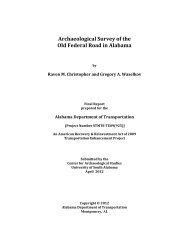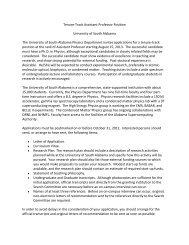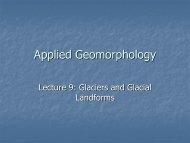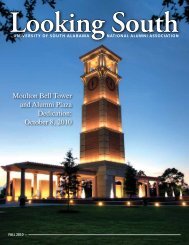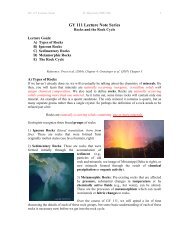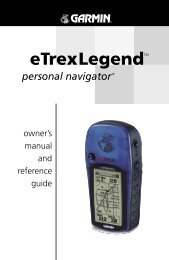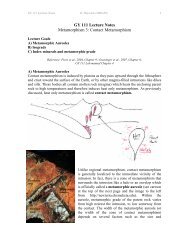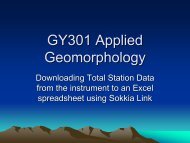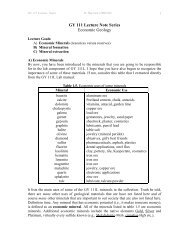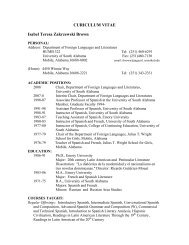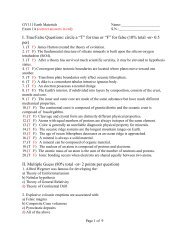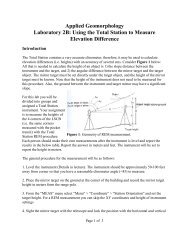Lecture 4: Weathering and Mass Wasting
Lecture 4: Weathering and Mass Wasting
Lecture 4: Weathering and Mass Wasting
- No tags were found...
You also want an ePaper? Increase the reach of your titles
YUMPU automatically turns print PDFs into web optimized ePapers that Google loves.
Applied Geomorphology<strong>Lecture</strong> 5: <strong>Weathering</strong> & <strong>Mass</strong><strong>Wasting</strong> Processes
<strong>Weathering</strong>• Chemical <strong>Weathering</strong>– Hydration: chemical reaction that consumes H 2 O [ 2KAlSi 3 O 8 +2H 2 CO 3 + H 2 O = Al 2 Si 2 O 5 (OH) 4 + 4SiO 2 + 2K + +2HCO 3- ]– Oxidation: chemical reaction that consumes oxygen [ Fe 2 SiO 4 +½O 2 = Fe 2 O 3 + SiO 2 ]– Dissolution: dissolving of minerals into solution [ NaCl + H 2 O =Na + + OH - + H + + Cl - ]• Physical <strong>Weathering</strong>– Ice wedging– Thermal stress– Spheroidal weathering– Biologic activity– Soil creep– Solifluction– Exfoliation
Chemical Stability of Rock FormingMinerals• Silicates correlate with Bowen’s ReactionSeries
<strong>Weathering</strong> examples• Fe-oxide formation from oxidation
<strong>Weathering</strong> Examples cont.• Joint patterns allowing physical <strong>and</strong>chemical weathering
<strong>Weathering</strong> Examples cont.• Biologic activity
<strong>Weathering</strong> Examples cont.• Frost wedging
<strong>Weathering</strong> Examples cont.• Exfoliation dome formation (Stone Mt. GA)
<strong>Weathering</strong> Factors• Climate– Rainfall– Average temperature– In some climates chemical weathering dominates, in othersphysical weathering dominates• Bedrock type (mineralogy)– Bowen’s Reaction series• Topography (Soil formation)– Steep: little or no soil– Flat: abundant soil• Duration of weathering process
Soil ProfileSchematic• A, B <strong>and</strong> C horizons• Porosity: % voidspace in material• Permeability: abilityto transmit a fluid
Soil Types• Pedalfer: originate in temperate humid climatezones. Well developed A, B <strong>and</strong> C horizons.• Pedocal: originate in arid <strong>and</strong> semi-aridtemperate climates. Contain abundant CaCO3 inB horizon; All horizons are poorly developed.• Laterites: originate in humid tropical climates.Contain mainly Al2O3. Horizons are poorlydeveloped.
<strong>Mass</strong> <strong>Wasting</strong>• Movement of material down-slope as the resultof gravity• Classified based on 2 parameters:– Type of material• Rock• Debris, earth• Mud– Velocity of motion• Fall, avalanche• Slide• Flow
<strong>Mass</strong><strong>Wasting</strong>
Rock Slide Example• Gross Ventre (near Jackson Hole,Wyoming)(photograph courtesy of A.G.I)
Gross Ventre Topographic Map
Slump Example• Upper portion of slump is a slide producinga noticeable “scar”• Lower portion is generally an earthflow(photograph courtesy of A.G.I)
• Slumps commonly affectman-made structures <strong>and</strong>are often triggered bypoor constructionpracticesSlump Example
Mudflow Examples• Lahar: driven by volcanic eruptions(Photo courtesy of USGS)
Soil Creep• Slow movement of soil downslope due to frostheave or cyclic wetting/drying.
Solifluction• Slow earthflow movement downslope in permafrostregions
• Moderately fastmovement ofunconsolidatedmaterial downslopeDebris Flow
• Free-fall of rockmaterial at highvelocityRock Fall
<strong>Mass</strong> <strong>Wasting</strong> “Triggers”• Seismic events/Construction Shocks• Volcanic eruptions (Lahars)• Undercutting/Slope modification• Rainfall• Rapid deposition (submarine turbidityflows)


